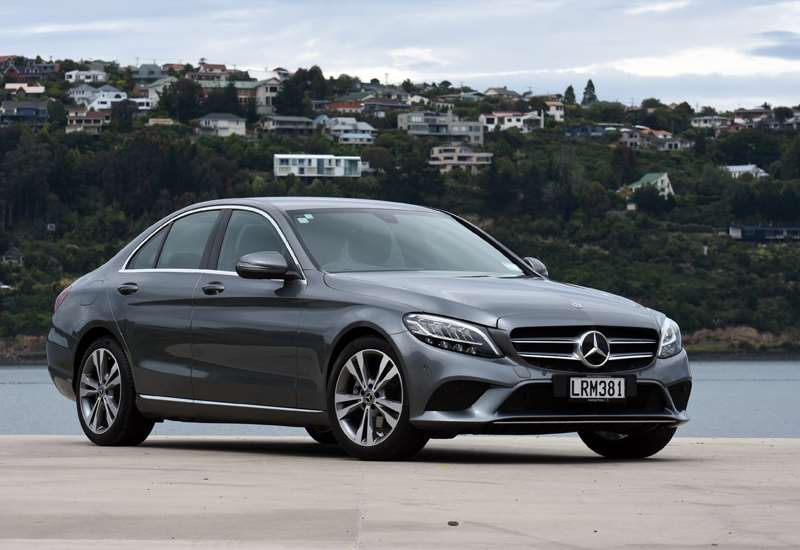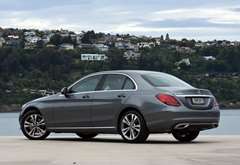Once were the days when a 2.0-litre four-cylinder petrol motor seemed barely enough for a car of this kind.
Now, of course, that’s a ‘‘big’’ capacity reserved for the C300 badge in pure petrol configuration or others — even AMG’s venerated C63 — with electric assist. The times have changed.
As for this C200? Beneath the bonnet . . . a 1.5-litre.
Could you tell? Agreed, responses are always rounded rather than head-smackingly urgent. Yet its progressive thrust is ample enough to dial up respectable pace and there’s enough on tap for instant gap-plugging or sudden overtaking from a cruising velocity.
So, realistically, anyone none the wiser might well imagine it was a larger engine. It’s a fascinating study, not least for outputs which would genuinely seem good in larger capacity company. In the 1.5-litre sector, they’re simply brilliant.
But that’s Mercedes for you. This is not a brand to do things by halves. When it engineers, it really engineers. Though the C200 is not as energetic off the line as the C300 –—with 0-100kmh taking 7.3 seconds (whereas the larger model does it in six flat) — nor as muscular in the mid-range, it doesn’t feel weak or insipid and has no issue working with the nine-speed auto that provisions across the whole C-Class family.
Plus, in addition to expressing quiet resolve, it’s also doing the world a good turn by sipping fuel. Mercedes claims a combined fuel consumption of 6.9L/100Km for this engine, whereas the 2.0-litre knocks it back at 7.3.
That in itself is really attractive at a time when the litre price of petrol is coming up to match that of world-best champagne, but what is more alluring is the potential for the car to better that result.
Achievable? From this experience, easily. The final stint of this test was a decent open-road run, almost wholly at 100kmh. The average economy for that leg came to 6.1 litres per 100km. The only previous C-Class sedans I’ve seen do better have run compression ignition.
The potential for enjoying very decent economy might not necessarily be a priority when you’re buying into a car that, in costing close to $90k as tested (the base package is $86,000 but this one had a $1700 Sport Package, metallic grey paint for $1600 and anthracite lime wood trim; for $700), is almost double the cost of a mainstream model of similar size and capability.
But, rest assured, the premium-ness that also attracts buyers to this badge also evidences coherently in this car. Plus you get a very decent dollop of comfort, space and junior S-Class kudos — the latter not simply through the latest C picking up on some styling elements first tried out on Mercedes’ flagship limo. Even the least expensive C-Class has some of the top model’s impressive technology, much operated via a touch screen that’s as impressive in its design and operability as its sheer size.
Most luxury sector cars now come with a raft of safety aids on board, but the C-Class definitely is not one in which you can easily find lapses. There is a LOT of smart electronic tech, some new to the category, and even though the best stuff is contained to upgrade packages that lift buy-in by $2400 to $3800, even in base factory provision the highest-volume Mercedes-Benz model of the past decade has features that were either unavailable or optional on the outgoing car. An important consideration given prices are up by $8900 and $10k respectively.
It has blind-spot assistance as standard, which isn’t the case for some of its competitors. There’s also the usual active lane-keep assist and active brake assist, both of which are, despite being at times a touch too sensitive, really important safety assists. You also get variable cruise control and the Sport provision implements the parking package, which includes a 360-degree camera. The C300 bumps up the accident-avoidance kit more, with an acronym-thick ‘driving assistance package plus’’, with one highlight being a side accident anticipation and protection system. However, even at entry level, all the important boxes are ticked.
Regardless that it’s not the ultimate spend edition, first impression when sliding behind the wheel is how swish this interior is and how closely it mirrors the S’s minimalist aesthetic. Sure, when you’re not spending absolute top dollar, you’re not achieving absolute luxury.
An entry C-Class not having a full leather interior is not such a bad thing these days; so many brands are now going for the ‘‘vegan’’ option as part of their effort to show stronger Green conviction. In saying that, Artico (Benz-speak for vinyl) does a seem a touch off the pace now. The cost-extra wood trim was a bit of a visual pep, though not overwhelmingly so; day grey trim in an overly black cabin only lifts the mood so far. However, one plus of an environment in which the surfaces are sombre-toned is that it brings out the full strength of the interior ambient lighting package, which is really something else.
The latest ergonomic approach swaps out many of its physical buttons in favour of touchscreen housing the latest version of MBUX infotainment and driver involvement technology, which Mercedes says has more processing power than the previous generation.
Set into the centre console and slightly tilted towards the driver, the touchscreen is larger of two Mercedes New Zealand could have chosen and it is massive. Its placement pushes the three air vents up above the display. The centre-console touchpad and controller knob found in the outgoing car have disappeared completely.
If you know MBUX already, the updated version is obviously improved yet fundamentally no different. If you are a first-timer, it might be best to spend some time attuning to basic capabilities before starting the engine.
Honestly, it’s not that daunting, just futuristic enough to be impressive without being overtaxing. But it does demand some learning simply because the button count is much diminished, and the ‘‘hey Mercedes’’ voice recognition, a console-mount touchpad and track pads embedded in the multifunction sports-styled steering wheel, also comes more to the fore for infotainment, nav and phone-related operability.
At least functions such as the windscreen wipers and lights are still operated by orthodox controls; there’s also the column-mounted gear selector that, sooner or later, is bound to be confused for an indicator wand.
Apple CarPlay and Android Auto now at last connect wirelessly. The navigation can be upgraded to include augmented reality, which utilises a forward-facing camera to show real-time directional assistance. This second-gen MBUX enables software updates via WiFi. But this isn’t a one-way thing.
In addition to receiving data it can also act as a command module. The ultimate trick, not yet involved for New Zealand operation, is a car-to-home function, with which you could turn on the living room lights, close the curtains and set a heat pump temp and also patch into a compliant home security system to check for intruders.
LED headlamps with headlamp assist and adaptive high beam assist are standard. Spend more and these will smarten up to digital types that can detect if a driver is about to run a red light or a stop sign, has accidentally driven the wrong way on to a motorway, or has crossed to the wrong side of the road.
Although the overall proportions look similar to the outgoing model, the first major redesign since 2014 is basically new from the ground up. In addition to a more aggressive look and cleaner profile, the body is 10mm wider and longer overall (by 65mm) and in wheelbase; the roofline has lowered 9mm to suit the more athletic stance.
Boot space remains pegged at 455 litres but cabin room has enhanced a touch, mainly for rear occupants, who achieve 35mm more knee-room and 13mm more head-room.
As much as it clearly feels impact of cost constraint, the C200 is one of those Mercedes cars whose price isn’t easy to accurately judge, in that it feels like a luxurious proposition to drive or be driven in.
How special does it feel to drive? That’s an interesting aspect. Truth be told, there’s really nothing spectacular going on, with light steering and an urban ride quality that’s is perhaps just a tad too firm for absolute comfort.
But, then, as you clock the kilometres, you start to be impressed by how quietly resolved it all is. As much as the engine’s traits are going to make it welcome for urban driving, the open road stuff is no challenge, either.
The entry model is an agreeable car, with a broader spread of capabilities than you might at first expect.
- Richard Bosselman. Photos: Richard Bosselman














